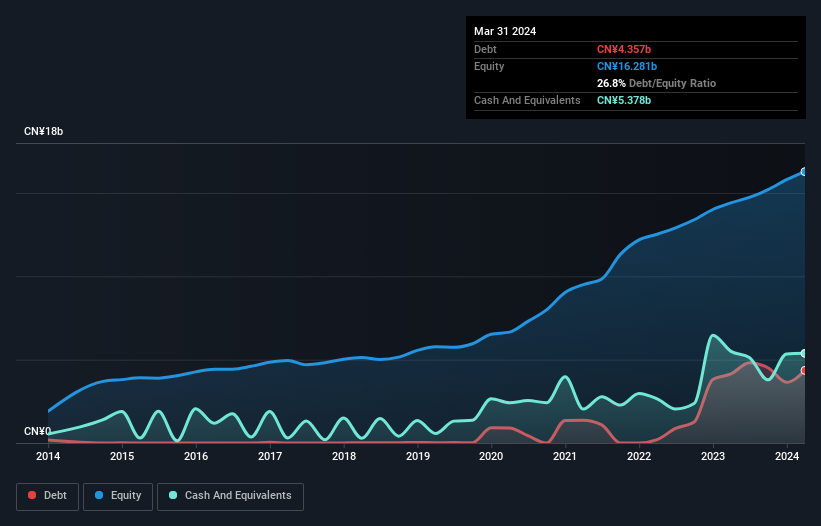- China
- /
- Semiconductors
- /
- SHSE:603806
Hangzhou First Applied Material (SHSE:603806) Seems To Use Debt Quite Sensibly

Legendary fund manager Li Lu (who Charlie Munger backed) once said, 'The biggest investment risk is not the volatility of prices, but whether you will suffer a permanent loss of capital.' So it seems the smart money knows that debt - which is usually involved in bankruptcies - is a very important factor, when you assess how risky a company is. We note that Hangzhou First Applied Material Co., Ltd. (SHSE:603806) does have debt on its balance sheet. But the more important question is: how much risk is that debt creating?
What Risk Does Debt Bring?
Debt assists a business until the business has trouble paying it off, either with new capital or with free cash flow. Part and parcel of capitalism is the process of 'creative destruction' where failed businesses are mercilessly liquidated by their bankers. However, a more frequent (but still costly) occurrence is where a company must issue shares at bargain-basement prices, permanently diluting shareholders, just to shore up its balance sheet. Of course, plenty of companies use debt to fund growth, without any negative consequences. The first step when considering a company's debt levels is to consider its cash and debt together.
View our latest analysis for Hangzhou First Applied Material
What Is Hangzhou First Applied Material's Debt?
As you can see below, at the end of March 2024, Hangzhou First Applied Material had CN¥4.36b of debt, up from CN¥4.14b a year ago. Click the image for more detail. However, it does have CN¥5.38b in cash offsetting this, leading to net cash of CN¥1.02b.

How Strong Is Hangzhou First Applied Material's Balance Sheet?
We can see from the most recent balance sheet that Hangzhou First Applied Material had liabilities of CN¥3.43b falling due within a year, and liabilities of CN¥2.92b due beyond that. Offsetting these obligations, it had cash of CN¥5.38b as well as receivables valued at CN¥8.98b due within 12 months. So it actually has CN¥8.01b more liquid assets than total liabilities.
It's good to see that Hangzhou First Applied Material has plenty of liquidity on its balance sheet, suggesting conservative management of liabilities. Because it has plenty of assets, it is unlikely to have trouble with its lenders. Succinctly put, Hangzhou First Applied Material boasts net cash, so it's fair to say it does not have a heavy debt load!
Another good sign is that Hangzhou First Applied Material has been able to increase its EBIT by 22% in twelve months, making it easier to pay down debt. There's no doubt that we learn most about debt from the balance sheet. But ultimately the future profitability of the business will decide if Hangzhou First Applied Material can strengthen its balance sheet over time. So if you're focused on the future you can check out this free report showing analyst profit forecasts.
Finally, a company can only pay off debt with cold hard cash, not accounting profits. Hangzhou First Applied Material may have net cash on the balance sheet, but it is still interesting to look at how well the business converts its earnings before interest and tax (EBIT) to free cash flow, because that will influence both its need for, and its capacity to manage debt. During the last three years, Hangzhou First Applied Material burned a lot of cash. While that may be a result of expenditure for growth, it does make the debt far more risky.
Summing Up
While we empathize with investors who find debt concerning, you should keep in mind that Hangzhou First Applied Material has net cash of CN¥1.02b, as well as more liquid assets than liabilities. And we liked the look of last year's 22% year-on-year EBIT growth. So we don't have any problem with Hangzhou First Applied Material's use of debt. There's no doubt that we learn most about debt from the balance sheet. However, not all investment risk resides within the balance sheet - far from it. For instance, we've identified 1 warning sign for Hangzhou First Applied Material that you should be aware of.
If you're interested in investing in businesses that can grow profits without the burden of debt, then check out this free list of growing businesses that have net cash on the balance sheet.
Valuation is complex, but we're here to simplify it.
Discover if Hangzhou First Applied Material might be undervalued or overvalued with our detailed analysis, featuring fair value estimates, potential risks, dividends, insider trades, and its financial condition.
Access Free AnalysisHave feedback on this article? Concerned about the content? Get in touch with us directly. Alternatively, email editorial-team (at) simplywallst.com.
This article by Simply Wall St is general in nature. We provide commentary based on historical data and analyst forecasts only using an unbiased methodology and our articles are not intended to be financial advice. It does not constitute a recommendation to buy or sell any stock, and does not take account of your objectives, or your financial situation. We aim to bring you long-term focused analysis driven by fundamental data. Note that our analysis may not factor in the latest price-sensitive company announcements or qualitative material. Simply Wall St has no position in any stocks mentioned.
Have feedback on this article? Concerned about the content? Get in touch with us directly. Alternatively, email editorial-team@simplywallst.com
About SHSE:603806
Hangzhou First Applied Material
Designs, develops, manufactures, and sells solar battery encapsulation materials in China and internationally.
Excellent balance sheet average dividend payer.
Similar Companies
Market Insights
Community Narratives


